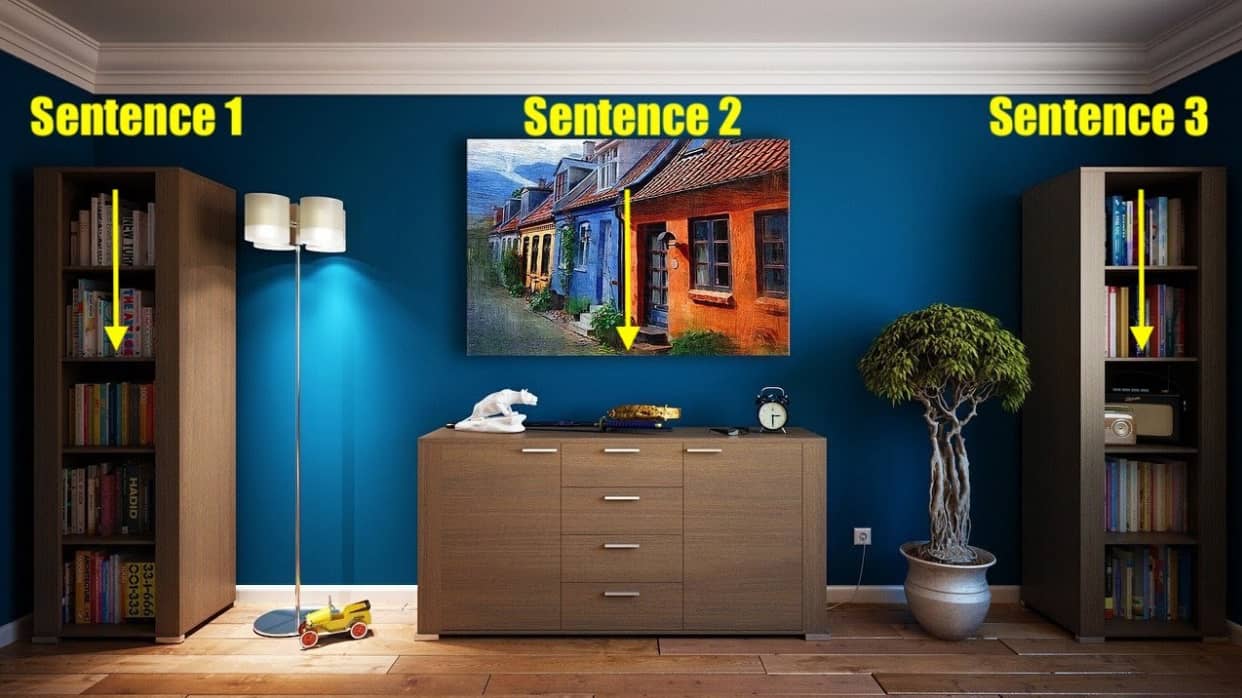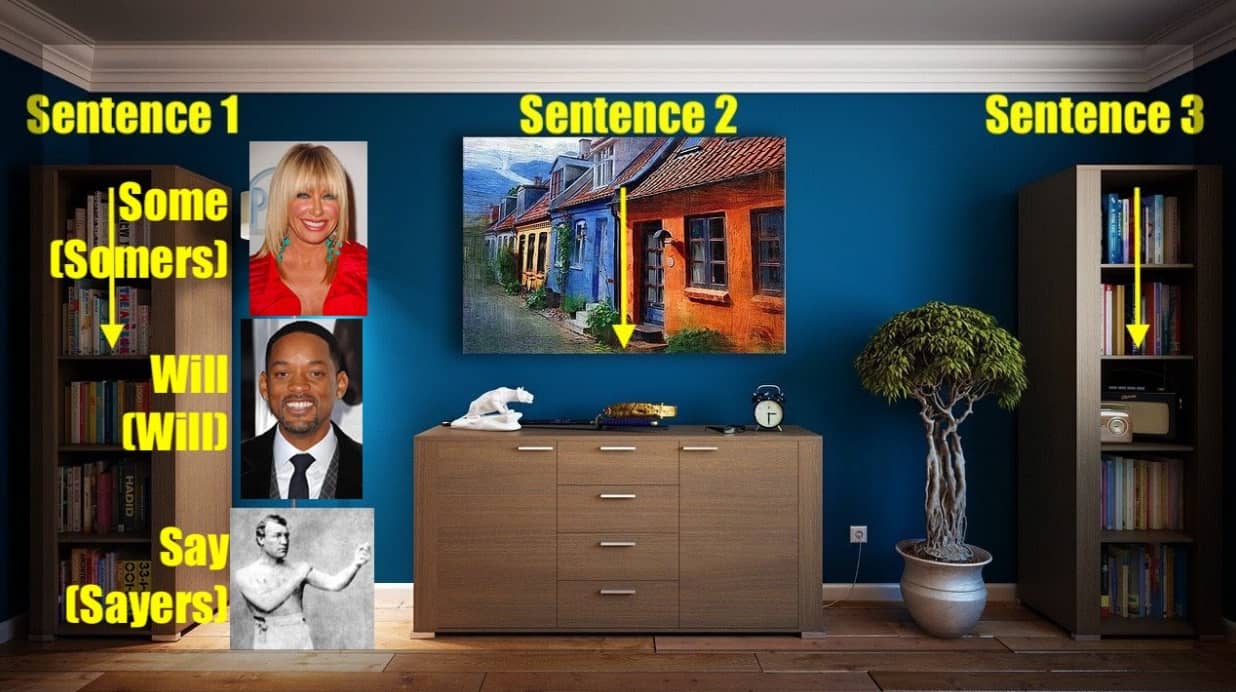Podcast: Download
Subscribe: Apple Podcasts | RSS
 Want to know how to memorize a paragraph fast?
Want to know how to memorize a paragraph fast?
Tired of the standard advice about using linking and rote repetition?
I hope so, because it’s bad advice.
Why?
Because linking and “chunking” are often more overwhelming than repeating sentences over and over again.
Well, you’re in luck.
I’ve memorized many paragraphs and on this page will show you how to do it. With specific examples and a demonstration.
You’ll learn the technique progressively and exactly how the old memory masters used to memorize entire books.
Back during the Renaissance, top performers basically had to carry entire books in their heads because books were rare and expensive back then. That’s why they needed the techniques you’re about to learn.
And those techniques still work today.
So let’s dive in.
How To Memorize A Paragraph Quickly
Few things could be easier than memorizing paragraphs verbatim.
Whether it’s part of school exams or a technique you’re using to learn a language through passage study, the key is that you learn and follow a reliable process.
Step One: Familiarize Yourself With The Paragraph’s Length
First, count how many sentences you’re dealing with.
Often, we trick ourselves into thinking that the material is longer than it actually is, leading to feelings of overwhelm.
As Barbara Oakley points out in Mindshift, however, there are neurological reasons why we feel this way. You can reduce any sense of overwhelm easily by taking a moment to familiarize yourself with the exact amount that needs memorization.
Step Two: Get Your Mouth Involved
Read the paragraph aloud and get a sense of its general tone.
Notice any words that leap out at you or that you don’t understand. If you need to look something up, now is the time so that you’re not slowed down later.
This point is important:
If you truly want the best way to memorize a paragraph, you need to remove all obstacles first. Words you don’t understand are one of the first things to tackle so that they aren’t obstacles anymore.
Step Three: Prepare To Place Your Paragraph In A Memory Palace
Once you know how many sentences are in the paragraph, create or identify a Memory Palace. It should have enough space to accommodate the amount you need to memorize.
Ideally, you want your Memory Palace design to have a structure that will accomodate the paragraph you need to memorize. To do this with the many paragraphs in my TEDx Talk, I used the Pillar Technique. I’ve illustrated it for you in this image:
Basically, how it works is that you mentally “paint” each sentence in rooms using columns that run from the top to bottom. In the Magnetic Memory Method Masterclass, there are several sections that detail more about how to use the Pillar Technique.
With this approach, I’ve been able to memorize up to 17 words on a single Pillar.
Usually, you can get 4-8 sentences in a single room when you’re using the walls and the corners (8 Pillars per room).
How To Memorize Sentences Fast In Your Memory Palaces
Now let’s look deeper at the process of memorizing the individual sentences in your paragraph.
Although this point might seem obvious, it’s worth making:
Before you can memorize an entire sentence, you need to be able to memorize words.
The ancient memory master who wrote Rhetorica ad Herennium circa 90 BCE made this point very clear.
To paraphrase, the author says:
Those who wish to memorize more difficult things must first learn to memorize words.
Learning how to memorize vocabulary is very good advice. It is the path to being able to memorize more than one word at a time.
So how do you do it?
Step Four: Use Associations For Each And Every Word In The Paragraph
In the beginning, you might be be able to memorize only around 1-3 words per station. Don’t stress it: We all start somewhere.
When I started, I needed an association for each and every word.
To apply your associations quickly on a word-by-word basis, you want to develop your skills by learning the pegword method
Let’s say the sentence you want to memorize is from Plato’s apology:
Someone will say: Yes, Socrates, but cannot you hold your tongue, and then you may go into a foreign city, and no one will interfere with you?
Later, you’ll be able to compress “Someone will say” into a single image. But for now, just focus on “Someone.”
If you have your tools ready, maybe a famous actress like Suzanne Somers has already come to mind. Maybe she has a sum of gold in her hand. She may even be under the summer sun.
Step Five: Use Dynamic And Gripping Associations
By making alphabetical-sound associations between like-sounding words that evoke dynamic images, it’s easy to make associations.
I highly recommend you develop parts of your pegword system based on celebrities so that these associations can be richly evocative.
I sometimes refer to this as a “Celebrity List.” You can also build them from:
- Politicians
- Friends
- Family
- Teachers
- Musicians
- Artists
- Authors

It’s easier to imagine a familiar association doing something that triggers back the target words when you’re memorizing sentences.
For example, to add “will say,” you can have Suzanne Somers with a character from the movie Good Will Hunting, or Will Smith. She can be saying something to Will Smith, or even to Tom Sayers.
From there, move on to the next word. And as you go, I highly suggest you place these associations in a Memory Palace. That way they’re not floating in the void of your mind. It will also help with recalling the sentences word-for-word later.
Step Six: Use Proper, Science-Backed Spaced Repetition
Sometime when people hear about the Memory Palace technique for verbatim learning goals, they think about Sherlock Holmes.
However, this technique is real and to use it in reality, we need to draw upon the findings of memory science.
One of those findings is a principle called spaced repetition.
In brief, you need to revisit the images you’ve placed in the Memory Palace on a timed pattern.
There’s no cookie-cutter, one-sized-fits-all number that tells you exactly how many times you need to repeat the memorized passage.
But a good rule of thumb is to go through it at least five times. When you’re really good with Memory Palaces and the kinds of mnemonic images I’m sharing with you on this page, you’ll soon be able to commit paragraphs to memory a lot faster and with fewer repetitions.
How To Memorize A Passage Fast
Let’s say that you’ve mastered paragraphs.
What about how to memorize a long passage?
That’s exactly what I faced when I had to memorize and then deliver a speech at a TEDx event.
The talk was 1506 words divided over 60 paragraphs!
Luckily, I had no problem memorizing it quickly with this as the result:
Now, there are different Memory Palace examples you can explore. In this case, I used an entire neighborhood. It started in a building, but then moved out over several streets.
All you have to do is start preparing Memory Palaces like these in advance. With a general estimation, you should be able to accommodate any passage of any size in most neighborhoods.
And if you need more space, just add more buildings and neighborhoods.
One of the benefits of using neighborhoods is that you can then walk “through” the passage you’ve memorized.
Walking was one of the tips my speaking mentor Thomas Krafft suggested for instilling how I memorized this long passage of text.
I almost ignored the suggestion, but am glad I gave it a try. It’s not only good exercise, but does seem to deepen the associations and speed up the process.
Getting Sentences, Paragraphs And Passages Into Long Term Memory
So far we’ve talked about making associations. Memory scientists call this elaborative encoding.
However, to make the content we memorize stick, we also need active recall.
In brief, this means making the brain work a little to recall the associations and the target paragraphs.
To do this, you simply call back to mind the Memory Palace, then the association, then the information.
With training, you’ll find that the paragraph comes back to your memory faster than either the Memory Palace or the associations.
There are a few more ins-and-outs when it comes to using active recall for paragraph memorization. I call these my “repetition rules.”
Advanced: How to Memorize Numbered Paragraphs
Let’s say you not only want to memorize a paragraph. You also want to know exactly which sentence is 5th into the paragraph.
Or perhaps you need to know the Bekker numbers of a philosophical text. Scripture memorization often also involves memorizing numbered paragraphs.
In this case, you’ll want to employ an additional mnemonic device called the Major System. You use this to create a full 00-99 PAO. This means that you have an image for each number from 00-99.
That way, you can number every station in a Memory Palace in advance. Each station will have a pre-assigned association that you can trigger any time.
Although ambitious, this advanced approach to memorizing paragraphs is tremendously useful.
For example, it can help you compare two passages in two different books.
You Really Can Conquer Paragraphs Quickly
So long as you’re willing to set yourself up with the needed memory techniques, memorizing any paragraph will be a breeze.
Make sure that you go one step further, however. Effective learning is not just about regurgitating entire sentences, paragraphs or entire passages.
You also need to be able to understand the key points.
And to do that, I suggest you:
- Write your own summaries of the material
- Mind mapping key ideas
- Have discussions with others about the facts and concepts
- Follow-up with more reading from multiple sources
- Seek video and audio supplements to experience similar content in different media
If you’re memorizing the paragraphs for an exam, taking practice tests is highly recommended as well.
The more you include variety, the more opportunities for different levels of active recall you’ll get. And that means more memory benefits.
So what do you say?
Are you ready to get out there and start memorizing some paragraphs? If you have any questions, please just pop them below. I’ll get back to you a.s.a.p.
Or, feel free to complete my free course on comprehensive Memory Improvement:
It gives you four free video lessons and worksheets that makes sure your Memory Palaces are perfectly suited for memorizing paragraphs quickly.
You’ve seen through my personal example with the TEDx Talk that it’s possible.
Now all you need to do is develop your mnemonic tools and start applying them to whatever paragraphs you want to memorize.
Let’s do this thing!
Related Posts
- How to Memorize European Countries Fast
If you need to know how to memorize European countries fast, the standard memory techniques…
- How to Memorize the Unit Circle Fast
Learning how to memorize the unit circle shouldn't take longer than an afternoon. The best…
- How to Memorize The Quran Fast: 10 Proven Steps
This detailed guide helps you learn how to memorize the Quran. Learn to commit the…








